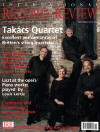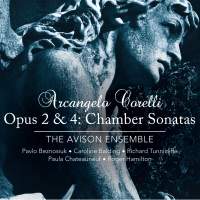Texte paru dans: / Appeared in:
*

International Record Review - (11//2013)
Pour
s'abonner / Subscription information
Linn
CKD413

Code-barres / Barcode : 0691062041324
The continuing survey by Linn Records of the instrumental works of Arcangelo Corelli reaches completion in 2013, marking the 300th anniversary of the composer’s death ( earlier volumes were reviewed in February and March this year) . This persuasive series of recordings has by now emphatically redefined our expectations, experience and comprehension of the music of this great master of the Italian Baroque. With flawless and often revelatory performances by the Avison Ensemble directed by Pavlo Beznosiuk, this project has established itself as a definitive recorded compendium of Corelli’s works, to which this latest release now adds the Trio Sonatas , Op. 2 and 4 to the Op. 5 Violin Sonatas and the six Concerti grossi of Op . 6. No comparable set of Corelli recordings offers performances of such brilliance and scholarly insight and here, as before, these new accounts can only be applauded and welcomed without qualification, for this is music-making of the highest order.
Corelli wrote the 12 Op. 2 works for Cardinal Benedetto Pamphili, into whose employment the composer had entered in 1684. The Cardinal’s famously opulent and extravagant lifestyle sat curiously at odds with his supposed calling, however, and attracted censure from the Pope himself. It also led to Pamphili’s removal from Rome to Bologna in 1690, whereupon Corelli entered the service of Cardinal Ottoboni, whose court at the Palazzo della Cancelleria was famous throughout Europe for its cultivated tastes and patronage of the arts, and of music and musicians in particular. A letter written by James Drummond, Earl of Perth, who visited the Cancelleria in the autumn of 1695, observed that Ottoboni had ‘the best musique in the world, and is glad when strangers go to the house and take the pleasure of its diversions . . .‘.
Corelli’s Op. 4 set of Trio Sonatas appeared with a dedication to Ottoboni in 1694. The earlier Op. 2 set, however, was the subject of one of the most infamous musicological scandals of all time. Within two months of publication in Venice and Bologna (it seems curious that nobody found reason to criticize the series when it first appeared in Rome); Corelli found himself embroiled in what became known as the ‘Affair of the Fifths ‘ , in ‘t, flagrant violations of the rule expressly forbidding the use of consecutive intervals of a fifth became the main talking point in the fashionable coffee houses of both cities. The Allemanda of Sonata No. 3 does indeed contain a notorious passage in which the first violin and bass lines descend in parallel fifths, which led to the ‘crime’ being (according to Giovanni Colonna) ‘hotly disputed in piazzas and shops with rising interest, prompting many in Italy apart from virtuosi to write giving their opinions, and many letters have appeared, all of which condemn the passage by Corelli’.
Another novel point common to both sets is the occasional use of the dissonance which occurs when the delayed resolution of a leading note at a cadence point coincides with the early sounding of the tonic in the melody line, a feature known as the ‘Corelli Clash’. Corelli was not alone in deliberately using both devices in his music, but that his doing so fuelled both public interest and critical consternation attests to the fact that his music revealed unprecedented degrees of cunning, originality and melodic appeal unmatched by any of his Italian contemporaries.
Such are the very attributes which Beznosiuk and his team seem to relish and they bring a fascinating mix of affection and exploratory daring to these boundlessly illuminating accounts. The recordings, made (as before) at St George’s Church, Chesterton, Cambridge in January 2010 and January 2012 , are breathtakingly transparent and palpably faithful and, in their very clarity and pin-sharp focus, serve to bring the incandescent allure of this playing fully to life. Of the two selected comparisons (both from Italian period ensembles), only Emanuela Marcante’s Tactus recordings with the ensemble Il Ruggiero can realistically compete with the Avisons, turning in adroit and athletic playing in a recording that’s pleasingly warm and natural, while the Ensemble Aurora directed by Enrico Gatti (on Glossa) are accomplished yet never inspirational in their recording of the Op. 4 set.
Once again Beznosiuk and the Avison Ensemble warrant the highest commendation for these exceptionally fine performances — as it says on spine of this attractively packaged set, just listen!
Cliquez l'un ou l'autre
bouton pour découvrir bien d'autres critiques de CD
Click either button for many other reviews


